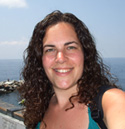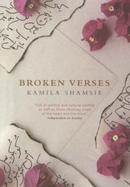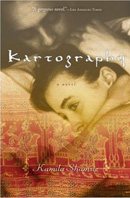
I discovered Kamila Shamsie through a friend who was singing the praises of her latest novel, Burnt Shadows. Eager to try her work, I devoured Burnt Shadows in only a few days. Its brilliance in both story and writing convinced me that I had to delve deeper into Shamsie's bibliography.
 Born in Pakistan in 1973, Kamila Shamsie is the author of five novels. Her home country, especially the city
of Karachi, is the setting for much of her writing. Shamsie holds a BA in Creative Writing from Hamilton
College in Clinton, New York, and a MFA from the University of Massachusetts, Amherst. She currently lives in
both Karachi and London, and writes for The Guardian.
Born in Pakistan in 1973, Kamila Shamsie is the author of five novels. Her home country, especially the city
of Karachi, is the setting for much of her writing. Shamsie holds a BA in Creative Writing from Hamilton
College in Clinton, New York, and a MFA from the University of Massachusetts, Amherst. She currently lives in
both Karachi and London, and writes for The Guardian.
Shamsie's novels have received much recognition. Her debut, In the City by the Sea, was shortlisted for the John Llewellyn Rhys Prize, and in 1999 Shamsie was awarded the Prime Minister's Award for Literature in Pakistan. Following the publication of her second novel, Salt and Saffron, Shamsie was named on the Orange Prize list of "21 Writers for the 21st Century." Her latest novel, Burnt Shadows, was shortlisted for the 2009 Orange Prize for Fiction.
Discovering a writer based on her newest book is a much different experience from reading a debut. Rather than
watching a writer progress, we see what she has become. By going back to the beginning, we can search for the roots
of the writer we instantly loved. So I went from Shamsie's latest novel back to her very first, In the City by
the Sea, and then to her third novel, Kartography. In these three novels I discovered many of the
same themes, and in all I read weighty, emotional prose spoken by realistic characters. In the City by the Sea
and Kartography revealed just how far Shamsie has come as an author. If a novel such as Burnt Shadows
can exist only five books into her career, I can only imagine what Shamsie's future novels will hold.
In the City by the Sea is set in an unnamed city in Pakistan (most likely Karachi) that is in midst of a political struggle. Hasan, at eleven, lives a perfect life with his loving parents, untouched by the turmoil in his city. This changes, however, when Hasan's uncle, Salman Mamoo, is put under house arrest for leading a rebel political party. Uncle Salman is Hasan's favourite person, and he is determined to help his uncle. As the troubles in Pakistan worsen, Hasan frequently slips into a world of imagination, and In the City by the Sea contains several of his fantasy quests to save Salman.
Hasan is a bright, interesting child, and his relationships with his parents and uncle are endearing. Shamsie
is successful in giving Hasan the voice of a child—seldom does he think or speak beyond his age. She fills
his character with precocious details; Hasan is never happier then when lying in his hammock staring at the night
sky, pomegranate in hand. He wakes to the sound of his neighbours playing cricket, and uses his favourite sport
as a way of escaping from the drama of his adult family members. Often authors struggle with writing realistic
child protagonists, but Shamsie succeeds. We see the problems of Karachi through Hasan's eyes, and so while this
political unrest affects many, we focus just on Uncle Salman's arrest. In the City by the Sea is not a
sweeping epic dealing with large-scale events, but a story of one boy's love for his family, and the role
imagination plays in the mind of a child.

Kartography contains many of the same themes as In the City by the Sea, but on a broader scale. Once again, Shamsie deals with child protagonists. Raheen and Karim have been best friends their entire lives, living next door to each other in an upscale Karachi neighbourhood. Their parents, Zafar and Yasmine, and Ali and Maheen, are also best friends, and they jokingly refer to the fact that their marriages are the result of a "fiancé swap" many years before.
Troubles in Pakistan cause Karim's parents to move their family to London, and the best friends are separated. As tensions mount at home, Raheen sets out to uncover just what happened between the two sets of parents years before. Interspersed into Raheen's narrative are flashbacks to the early 1970s, when the Bangladesh Liberation War caused political turmoil in Karachi. These flashbacks slowly unfold the secrets Raheen desperately wants to know—and later desperately wants to forget.
Kartography deals with the same troubles as In the City by the Sea, but this time, the reader is thrown into political arguments, forced to decide what is right and what is wrong. Gone is the naïve child narrator; Raheen grows into a young adult with opinions of her own, and though she tries to avoid the issues facing her country, she has no choice but to confront them.
Karachi plays a major role in Kartography. Like a character, the city has a personality all its own, with parts to love and parts to avoid. Karim is obsessed with maps, and the novel contains his hand-drawn sketches of parts of the city. In Karachi, roads are not called by their names, but by a shared memory: "the road with our favourite restaurant" or "the road where our car broke down". This frustrates Karim, while Raheen loves its impracticality—in fact, this road-naming trait becomes a metaphor for their differing perspectives on life, and on Pakistan's troubles.
Kartography is a beautiful book of friendship and love, and the regrets that can plague a person's life. Raheen's
narrative is engaging, and the flashbacks to her parents' youth are stunning, full of the tensions facing Pakistan.
Shamsie's third novel takes the issues of her debut and places them on a larger scale, demonstrating her ability to write
not only about a family, but about a country.

With every novel, Shamsie gives her stories a larger range—from family drama in In the City by the Sea, to the issues of a country in Kartography, and finally to the world-wide, multi-generational epic of Burnt Shadows.
The opening page of Burnt Shadows is of a man entering a prison. He is instructed to strip naked, and is left shivering in a cell. No indication is given of time or place. We soon forget about this man.
Next we are transported to Japan, 9 August 1945. Hiroko Tanaka lives in Nagasaki, a teacher engaged to marry Konrad Weiss, a German man who has lived in Japan since before the beginning of World War 2. The love between these two characters is clear, and the reader is given just enough time to yearn for their happiness when tragedy strikes, and Nagasaki is destroyed. Konrad is killed, and Hiroko is left alone in the world, scarred by the burns on her back and the pain in her heart.
Two years later Hiroko travels to India to seek out Konrad's sister Elizabeth, living in Delhi with her husband James. Elizabeth and Hiroko become close friends, and Hiroko manages to find love again with Sajjad Ashraf, James' assistant. Over the next several decades, the ups and downs of life take Hiroko's family across continents, first to Pakistan, on to New York City, and finally to Afghanistan immediately following 9/11.
Pakistan plays a much smaller role in Burnt Shadows, as Shamsie ventures beyond her homeland. Still, place is very much an important concept, and the descriptions of Japan, India, and Afghanistan add new characters to the novel. With Hiroko's life taking her far from Nagasaki, there is a sense that home is not a place, but the people in your life. Her bonds with Sajjad and Elizabeth are deep and complex, riddled with ethnic tensions and past mistakes, but they are solid and lasting too.
Like Kartography, Burnt Shadows deals with challenging issues, and once again Shamsie confronts the reader with political debates and moral uncertainties. No character is perfect—as much as I loved Sajjad, there were parts of him that I very much disliked, and even Hiroko has her trying moments. These flaws make Shamsie's characters real, and so the reader is drawn even further into her writing, taking sides in family arguments, feeling pain at tragic events, and understanding one character's final, horrible sacrifice.
Burnt Shadows eventually comes full circle, and that prisoner from the opening pages makes another appearance
in an ending that will leave you breathless. This story is not just Hiroko's, but instead is the story of the last
sixty-five years of human existence. We may think we have come a long way since Japan in 1945, but after reading
Burnt Shadows, we see just how little things have changed.
Kamila Shamsie's In the City by the Sea, Kartography, and Burnt Shadows display an author who has progressed from writing quiet family tales to sweeping epic novels. Underlying this change is the constant importance of place, and the beauty and pain of human relationships. Burnt Shadows is an ambitious novel, one that made me reflect upon the very nature of our world. It convinced me to delve deeper into Shamsie's works, and there I found an author who has lots to say about human existence. These are novels worth reading, and worth treasuring.

Caitlin Fehir is an English teacher living in southern Ontario, Canada.
Her reading tastes change daily, and she is constantly adding to her never-ending list of books
to explore. Her new-found love is traveling, an expensive hobby that is supplemented by seeing
the world through literature.




